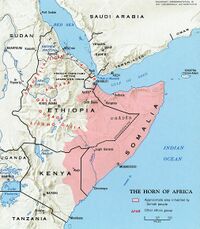لغات الصومال
| لغات الصومال | |
|---|---|
 Map of Somali language distribution.af soomaali | |
| اللغة الرسمية | الصومالية و العربية |
| لغة إقليمية | Maay Maay (South West) Soqotri (Puntland) |
| لغات المهاجرين الرئيسة | Oromo, Mushunguli |
| اللغات الأجنبية الرئيسة | English, Italian |
| لغة الإشارة | Somali Sign Language |
| Common keyboard layout(s) | |
يتكلم المجتمع الصومالي باللغة الصومالية. تتميّز اللغة الصومالية باكتمال خصائصها البنيوية، كما أنّها غنية بآدابها الشفهية. تنتمي إلى فصيلة اللغات الكوشية من أسرة اللغات الأفروآسيوية. وتشترك اللغة الصومالية مع اللغات الكوشية الأخرى في خصائص لغوية واضحة، في المستويات الصوتية، والمفرداتية، والصرفية، والنحوية. وتظهر هذه القربى اللغوية بصورة أوضح في مجموعة الكوشية الشرقية التي تنتمي إليها اللغة الصومالية. تقترب اللغة الصومالية من اللغات الكوشية الأخرى بدرجات متفاوتة، ويعتبر لغة أويرا“Aweera” أو بوني "Boni" أقرب اللغات الكوشية إلى الصومالية، وتأتي بعدها لغة رنديلي “Rendille” ، وتسمى لغات سم (Sam Languages)؛ ثمّ تأتي لغة بايسو " Bayso " ، فلغة دسينج " Dasenech "، فلغة أربوري " Arbore "، وتسمى لغات أوموتانا أو الصومالية الممتدّة؛ فاللغة الأورومية، ثمّ لغة عفر وساهو.
تقرر كتابة اللغة الصومالية بالحرف الروماني في أكتوبر 1972 رسميا. و الأصوات الصامتة في الصومالية المدونة هي (22) صوتا، بما فيها الهمزة ويرمز لها بـ(’)، وتكتب في وسط الكلمة ونهايتها، ولا تكتب في بداية الكلمة. وأما الحركات أو الأصوات الصائتة هي عشرة: خمسة قصيرة وخمسة طويلة.
. . . . . . . . . . . . . . . . . . . . . . . . . . . . . . . . . . . . . . . . . . . . . . . . . . . . . . . . . . . . . . . . . . . . . . . . . . . . . . . . . . . . . . . . . . . . . . . . . . . . . . . . . . . . . . . . . . . . . . . . . . . . . . . . . . . . . . . . . . . . . . . . . . . . . . . . . . . . . . . . . . . . . . . .
اللغات الكوشية والقرنية
اللغة الصومالية
 |
| جزء من سلسلة عن |
| ثقافة الصومال |
|---|
| الثقافة |
| الشعب |
| الدين |
| اللغات |
| السياسة |
Somali is the official language of Somalia and as the mother tongue of the Somali people, is also its endoglossic language.[1][2][3] It is a member of the Cushitic branch of the Afro-Asiatic family, and its nearest relatives are the Afar and Saho languages.[4] Somali is the best documented of the Cushitic languages,[5] with academic studies of it dating from before 1900.
As of 2006, there were approximately 16.6 million speakers of Somali, of which about 8.3 million reside in Somalia.[6] Of the five Somali federal states, all of them solely implement the Af-Maxaa-tiri dialect, except for the South West state, which officially uses it in combination with the Af-Maay-tiri, commonly known as Maay Maay.[7] The Somali language is spoken by ethnic Somalis in Greater Somalia and the Somali diaspora. It is spoken as an adoptive language by a few ethnic minority groups in these regions.
وصلات خارجية
- Ethnologue report on "Languages of Somalia"
- L'aménagement linguistique dans le monde, "Somalie"
- PanAfriL10n page on Somalia
- ^ Onwuegbule, Chinyere Gift, Chukwuka A. Chukwueke, and Nkama Anthony Ezeuduma. "OPTIMAL INDIGENOUS LANGUAGE USE AS STRATEGY FOR NATIONAL DEVELOPMENT." The Melting Pot 4.1 (2018).
- ^ "The Federal Republic of Somalia - Provisional Constitution" (PDF). Archived from the original (PDF) on 24 January 2013. Retrieved 10 September 2012.
The official language of the Federal Republic of Somalia is Somali (Maay and Maxaa-tiri), and Arabic is the second language.
- ^ "Somalia". World Factbook. Central Intelligence Agency. 2009-05-14. Retrieved 2009-05-31.
- ^ I. M. Lewis, Peoples of the Horn of Africa: Somali, Afar and Saho, (Red Sea Press: 1998), p.11.
- ^ Lecarme, Jacqueline; Maury, Carole (1987). "A software tool for research in linguistics and lexicography: Application to Somali". Computers and Translation. 2: 21–36. doi:10.1007/BF01540131. S2CID 6515240.
- ^ "Somali". SIL International. 2013. Retrieved May 4, 2013.
- ^ Taylor, Christian, Tanner Semmelrock, and Alexandra McDermott. "The Cost of Defection: The Consequences of Quitting Al-Shabaab." International Journal of Conflict and Violence (IJCV) 13 (2019): a657-a657.